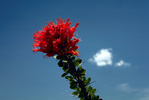Joshua Tree National Park, located in Johsua Tree, California, is a place full of life. Within the desert landscape of the park live many beautiful and elusive creatures. In the year that I lived there, I saw that as the seasons changed, so did the the animals, plants, birds and reptiles that populated the rocky outcrops and sandy valleys.
Summer
A Bighorn Sheep in Joshua Tree National Park, Joshua Tree, CA © 2004
Summer is hot and dry, but occasionally summer monsoons hit and old Barker Dam fills up and becomes a temporary lake. When that happens many organisms come to life! The most surprising development of the weeks of water were the thousands of red spotted toads that hatched and began to hop about in all the nooks and corners of the newly formed lake and puddles in the desert around it. Equally as miraculous were the birds, such as a white crane, that came to partake of the cool water. At night the dam is closed to visitors so that Bighorn Sheep can drink in peace in the evenings.
One afternoon as we climbed on a rock formation, two mojave rattlesnakes appeared. One coiled and rattled, the other darted toward us and looked as if it were attempting to ascend the face.
Autumn

Canis latrans Photo courtesy U. S. Fish and Wildlife Service
In a year of monsoon the riot of life that explodes after the water has come is an amazing sight. After the rains, the red spotted toads grew larger, the coyotes gorged on ripe prickly pears, and yellow chinchweed carpeted the desert sands. Even columbines grew in sandy washes. Less welcome was the profusion of ragweed which caused everyone around a lot of sneezing and wheezing! Also a nuisance were the introduced bullfrogs that are known to decimate some native species.
...In the afternoons Antelope ground squirrels scurry around the rocks, but a bitter wind often blows. As the sun sets, the dry grass glitters in the sun. Winter is coming!
Winter

Fonquieria splendens U.S. Fish and Wildlife Service
Joshua Tree National Park encompasses two deserts, the Colorado Desert, a western extension of the vast Sonoran Desert, and the Mojave Desert. Taking a trip to the south end of the park, and warmer weather, one can see flora of the Sonoran Desert, like ocotillo, and brittlebush, still blooming. Back in the Colorado, and in the realm of the Joshua Tree, everyone hopes for snow. It is theorized that Joshua Trees may branch off after a frost.
Winter migrants arrive. I sight the white-crowned sparrow and dark-eyed junco that have come to visit. The ravens circle often. Too many ravens now populate the park and threaten the existence of other winged creatures, as well as desert tortoises.
Spring
Sphaeralcea ambigua. Johsua Tree National Park © 2003
Spring is the time of wildflowers in Joshua Tree. Yellow, pink,
white, purple and red extend over the sand in a profusion of color that is
hard to believe after the months of beige and brown. You can visit the Johsua Tree web site to see what is in bloom.
Hurrah for spring! Spring in the desert feels like
paradise. Wandering happily in remote areas of the park, I wonder, half in
fear, half in excitement, if I might spot a shy mountain lion.
A List of Some Organisms Seen in the Park
Here is a list of some of the organisms that I was able to see during a year spent wandering the park:
- birds
- red tail hawk
- crane
- cactus wren
- dark-eyed junco
- ravens
- snakes
- mojave rattlesnake
- western diamondback
- king snake
- mammals
- bighorn sheep
- antelope ground squirrels
- red fox
- coyote
- arachnids
- tarantula
- scorpions
- desert tortoise
- lizards
- frogs and toads
- red spotted toads
- bullfrog
- plants
- joshua trees
- ragweed
- cacti
- cholla cactus
- old man cactus
- wildflowers
- chinchweed
- columbines
- desert marigold
- desert mallow
- desert chicory
 Go to quick links
Go to quick
search
Go to navigation for this section of the ToL site
Go to
detailed links for the ToL site
Go to quick links
Go to quick
search
Go to navigation for this section of the ToL site
Go to
detailed links for the ToL site


